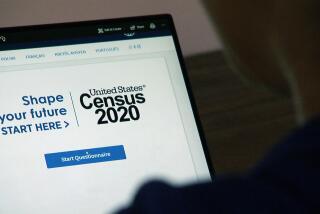Official Racial Definitions Have Shifted Sharply and Often
- Share via
Thirty years after segregation was outlawed in the United States, people are still consumed by efforts to define race.
Although the federal government has been collecting information about race for more than 200 years, official racial distinctions-- each seemingly so rooted in the scientific truth of its day--have changed as quickly as the seasons.
In creating legal racial distinctions, public officials often have accepted the guidance of anthropology and genetics when it supported the popular prejudice of the day, and ignored it when it did not, ethnic and legal experts said.
At the turn of the century, Irish, Italians and many central European ethnic groups were considered distinct “races” whose alleged hereditary low intelligence and propensity for drunkenness and crime so endangered the public good that Congress imposed immigration quotas on them.
Today, such official attitudes based on outmoded theories of heredity and inherited behavior have been discredited.
Despite the continuing appetite for information about race in America, officials have never been able to create an acceptable and consistent definition of racial difference.
Over the years, formal racial definitions of white and black each have encompassed the entire spectrum of skin color, changing in every other U.S. census since the Civil War. The U.S. Office of Management and Budget is revising them yet again this year.
Congress and the courts have tried to do what science cannot--define the difference between white people and black people in America, by arbitrating between who is white or nonwhite for purposes of immigration or naturalization, said Ian Haney Lopez, a Rockefeller Fellow at the Stanford University Humanities Center and author of “White by Law: The Legal Construction of Race.”
Depending on the era, American officials classified Chinese immigrants--but not Japanese--as “colored.” Armenians were classified as white in some decades, but not in others. People of Mexican ancestry were first classified as a separate race, then as white, and today as Hispanic.
To compound the racial confusion, children of mixed ancestry who were considered legally white in one state often were considered legally black in another.
Indeed, when it comes to juggling legal concepts of race, federal judges all the way up to the U.S. Supreme Court have had an easier time defining what a white person is not, than defining what one is.
“You would expect the courts to come up with a definition for what this phrase ‘white person’ means,” said Lopez. But “courts (repeatedly) refuse to do so and instead establish the nonwhiteness of the particular person before them.”
Ethnic studies experts say the fickle racial status of immigrants from India underscores the absence of any accepted scientific or biological definition of race.
In a series of court rulings and administrative decisions since the 1920s, the racial status of Indian immigrants has gone from “Hindu”--a religious designation used as a racial label--to Caucasian, to nonwhite, to white--and then most recently to “Asian Indian,” so Indian immigrants and their descendants could qualify legally for minority status.
The label is likely to change again before the next U.S. census.
“You can be born one race,” said Michael Omi, an ethnic studies expert at UC Berkeley, “and die another.”
More to Read
Sign up for Essential California
The most important California stories and recommendations in your inbox every morning.
You may occasionally receive promotional content from the Los Angeles Times.













